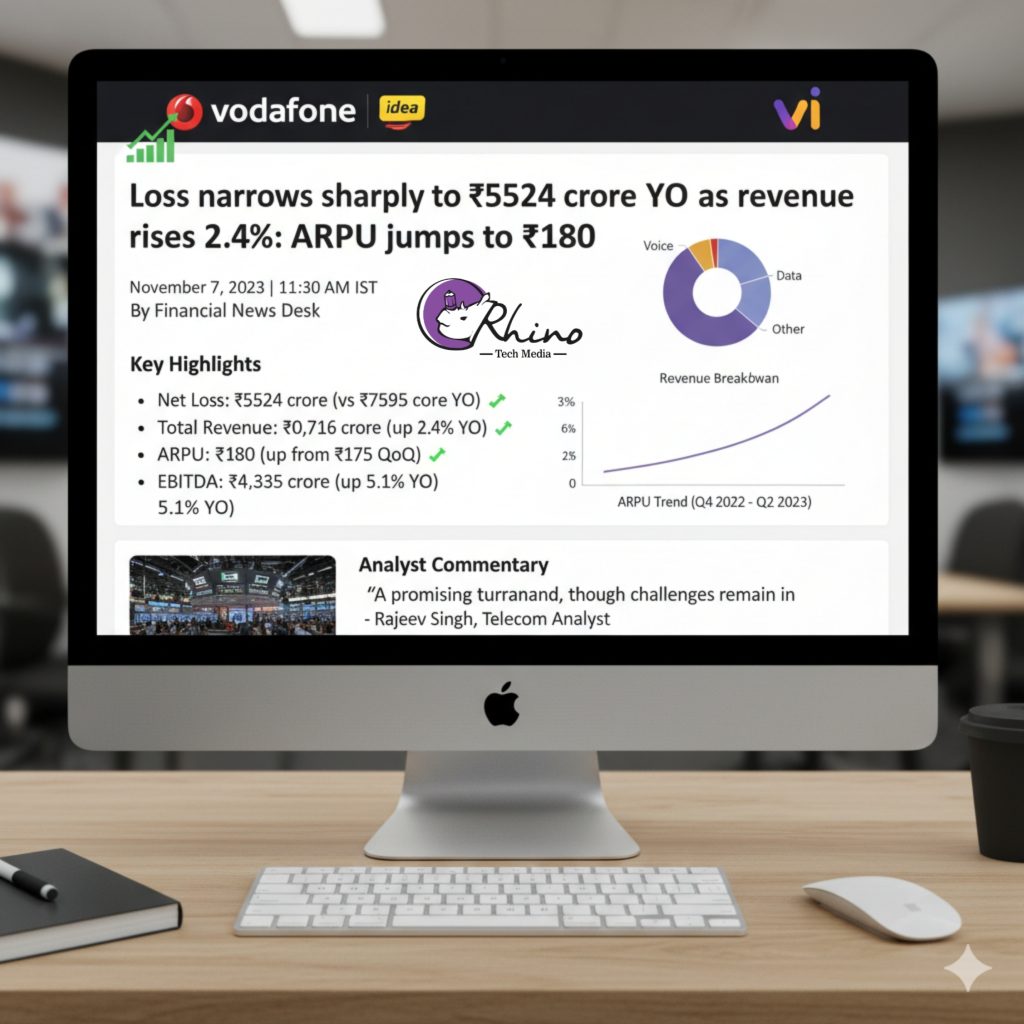Introduction
For a telecom operator that has been fighting an uphill battle for years, Vodafone Idea’s latest quarterly performance provides some modest relief — though by no means a clean bill of health. The numbers show signs of operational improvement, but the underlying structural challenges remain very real.
Key Financial Highlights
In the quarter ended 30 September 2025 (Q2 FY 26):
- Vi reported a consolidated net loss of ₹5,524 crore, significantly narrower than the loss of ~₹7,176 crore in the same quarter a year ago.
- Revenue from operations rose by 2.4 % year-on-year, reaching ~₹11,195 crore (from ~₹10,932-10,932.2 crore a year ago).
- The company’s Average Revenue Per User (ARPU) climbed to ₹180, up from ~₹166 a year earlier – an increase of ~8.7%.
- In terms of subscriber metrics: Total subscribers stood at ~196.7 million; of these, ~127.8 million were 4G/5G users (up from ~125.9 million a year ago).
- On the cost side, finance costs (interest, etc) saw meaningful declines: e.g., finance cost was ~₹4,784 crore in the quarter, down from ~₹6,613 crore a year ago.
- Vi also flagged some regulatory relief: the Department of Telecommunications (DoT) and the Supreme Court of India (SC) have allowed reconsideration of the company’s outstanding “Adjusted Gross Revenue” (AGR)-related liabilities from prior years — a possible positive for future cash flows.
What is Working
Several positive threads stand out:
- ARPU growth: The rise to ₹180 is encouraging. It suggests Vi is beginning to monetise its customers better via tariff increases or upgrades, which is essential for any telecom business.
- Revenue growth: A 2.4 % uplift in revenue in a challenging environment shows that the business is not stagnant — arguably a modest but important step.
- Cost/interest management: That finance costs fell significantly year-on-year is a positive sign for improving the bottom line and easing cash outflows.
- Network investment and 4G/5G rollout: Vi reports that its 4G population coverage has improved (to ~84 % of the population) and that its 5G services are live in 29 cities (covering all 17 priority circles where it holds spectrum) as of September 2025. This is crucial: having the network in place is key to offering value and retaining/attracting customers.
- Regulatory relief prospects: The AGR reconsideration gives hope of reduction in long-standing overhang and thus better future cash-flow and balance-sheet dynamics.
What’s Still Problematic / Risks
Despite the bright spots, Vi remains in a precarious position. Key concerns:
- Persistent Losses: Though the loss has narrowed, a ₹5,524 crore loss is still a large number. Vi remains unprofitable and the path to sustained profitability is unclear.
- Subscriber base decline or stagnation: While the 4G/5G user base rose, the total subscriber base is still under pressure (or shrinking). For example, one article notes a ~4 % decline year-on-year in total users. Losing lower-value users may help average metrics but puts pressure on volume, which matters in telecom.
- ARPU still lagging peers: Even though ₹180 is higher, Vi’s ARPU remains well below those of leading peers such as Bharti Airtel Ltd (ARPU ~₹256) and Reliance Jio Infocomm Ltd (ARPU ~₹211.4) as per some reports. That means Vi still has to play catch-up in monetisation.
- Heavy debt and deferred obligations: Vi’s total debt and deferred payment obligations (spectrum, AGR dues) run into trillions of rupees. One source puts total combined obligations at ~₹2 trillion. These large liabilities weigh on the company’s flexibility and increase risk.
- Need for future cash-flow and capex: The company is still in a state where it must invest significantly in network expansion (4G/5G) and improve service quality — all of which require cash. It is also dependent on regulatory relief (AGR) and fresh funding to make this happen. As one article states: “the group’s ability to settle the above liabilities is dependent on … government relief, fund-raise through equity and debt and generation of cash flow from operations.”
- Competitive pressure: The Indian telecom market remains aggressive, with peers moving fast on network, data offerings, and tariffs. Vi needs to ensure it does not fall behind in subscriber growth, retention, and service quality.
Strategic Implications & Outlook
Putting the pieces together, the Q2 result offers a “step forward” rather than a “turnaround”. Vi is showing that its operational levers (tariffs, ARPU, network upgrades) can work. But the strategic challenge is large: how to scale that improvement across volume, cost, debt, and market share.
Some strategic pointers:
- Focus on monetisation: With ARPU up, Vi should continue to push higher-value customers (4G/5G), shift users from older plans, and develop value-added services (video, enterprise IoT) to boost revenue per user further.
- Stop subscriber bleed / regain market share: Even as monetisation is important, the company must stem the loss of total subscribers, or at least stabilize it. Losing base means the denominator for ARPU growth shrinks and long-term scale suffers.
- Network investment with discipline: Given the heavy capex required for 4G/5G rollout, Vi must invest smartly (prioritising high-revenue circles, improving quality, indoor coverage) and also manage opex. The reported 4G population coverage of ~84 % and the rollout of 5G are positive. However, execution costs are high and competition is fierce.
- Balance sheet repair & regulatory relief: Arguably the biggest strategic imperative is to resolve the huge debt and deferred payment obligations. The recent Supreme Court decisions on AGR give hope, but actual relief or settlement remains to be seen. Without easing this burden, operational improvement may be constrained.
- Financial sustainability: To move from losses to profits, Vi must align revenue growth + margin improvement + cost control + lowered interest burden. The narrowing of loss is welcome, but the journey to profitability is still uphill.
Conclusion
In summary, Vodafone Idea’s Q2 FY 26 results are cautiously encouraging. A narrower net loss, revenue growth and rising ARPU all point in the right direction. The company is executing on network upgrades and is seeing reward in monetisation.
Yet, the structural vulnerabilities — heavy debt, regulatory overhang, subscriber shrinkage, competitive intensity — remain significant. The telecom business is inherently capital-intensive and scale matters. Vi’s favourable developments must now be amplified and sustained.
Ultimately, this quarter may mark a turning point from “retrenchment mode” to “recovery mode” — but recovery is not guaranteed. The next few quarters will be critical: can Vi convert rising ARPU and network investment into steady revenue growth, stabilise subscribers, and inch into profitability while managing its debt?
From an investor or stakeholder perspective, the message is: positive, but proceed with caution. The trajectory is upward, but the climb is steep.

